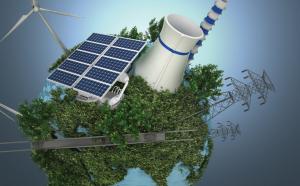Wind, nuclear, and gas resources must work together – not at cross-purposes.
John R. Norris serves as commissioner on the Federal Energy Regulatory Commission.
The role nuclear generation must play in our energy future has thus far received too little attention. Nuclear and renewable energy represent our only viable forms of carbon-free generation today, and are thus critical components for the U.S. to meet 2050 carbon reduction goals. But, nuclear energy is currently facing significant challenges that leave owners and developers of these resources uncertain about the future of nuclear energy. To achieve our carbon reduction objectives, those uncertainties must be resolved.

Nuclear generation currently makes up 20 percent of our electric generation.1 Nuclear facilities are extremely reliable generation resources, consistently operating in the 90 percent capacity factor range over the past decade.2 The low variability of fuel costs for nuclear plants also provides for long-term price stability. However, current gas prices have reduced energy prices to below some nuclear facilities' cost of production.3 In the past two years, five power companies have announced the retirement of six nuclear reactors.4 In addition, industry analysts are projecting the potential for more nuclear retirements in the near term due to revenue shortfalls.5 Each retired nuclear plant will increase both the difficulty and the expense for states to achieve the carbon reduction targets under the EPA's recently proposed Clean Air Act section 111(d) rule.6
While many expect that as a result of 111(d) our generation fleet will become increasingly reliant on natural gas, 111(d) does assume that much of our existing nuclear fleet will remain intact. But, as I explain in more detail below, our nuclear fleet is under significant economic stress due to a number of factors. It appears that we will be unable to achieve our carbon objectives, both for 2030 and 2050, if we intend to replace nuclear generation retiring in the near term solely with natural gas generation.7
While we have seen a reduction in carbon emissions over the past five years as a result of gas displacing coal, using gas to replace nuclear generation will reverse that trend. As discussed below, the rush to build new gas generation facilities could succeed in meeting the proposed 111(d) emissions reduction requirements for 2030, but may also make meeting the 2050 carbon reduction goals extremely difficult. States currently relying on nuclear generation may find themselves adding to their 111(d) challenge if measures to maintain the nuclear fleet are not taken.
The numbers are compelling.
 John R. Norris serves as commissioner on the Federal Energy Regulatory Commission.
John R. Norris serves as commissioner on the Federal Energy Regulatory Commission.
• 2,417 MMT of CO2 were emitted by our generation fleet in 2005.8
• 1,692 MMT of CO2 emissions represents the 2030 target level for our generation fleet under 111(d), based upon a 30 percent reduction from 2005 carbon emission levels.9
• 1,511 MMT of CO2 were emitted by coal-fired generation in 2012.10
• 493 MMT of CO2 were emitted by gas-fired generation in 2012.11
• 483 MMT of CO2 emissions represents the 2050 target level for our generation fleet, based on an 80 percent carbon reduction from the 2005 carbon emission levels.12
Thus, our gas-fired fleet already emits more CO2 than our 2050 emissions goal for our entire generation fleet, illustrating the challenges of relying solely on natural gas as the means to achieving the 2030 carbon reduction goals.
To work towards achieving both 2030 and 2050 carbon reduction goals, therefore, we must also focus on maintaining current levels of nuclear energy production and investing in new renewable generation, rather than simply looking to natural gas for answers. Yet current policies are failing to send the appropriate signals for much needed investments in maintaining our nuclear fleet and in new renewable energy generation.
The nuclear industry has been publicly highlighting the economic challenges faced by our country's nuclear fleet because of low natural gas prices, the entry of renewable generation, and flat demand growth. The challenges have led to insufficient revenues for some nuclear units in the FERC-jurisdictional markets. Those markets have been significantly impacted by the abundant supply of low cost gas that is setting market prices at the low end of the nuclear marginal cost range, resulting in some nuclear plants losing money. To a much lesser degree, if those plants happen to be located in one of a limited number of transmission-congested areas with significant wind generation, further losses are occurring in the very limited times when negative pricing occurs. Yet, despite the significant impact of low-cost gas, some nuclear plant owners are primarily targeting the Production Tax Credit and the resulting growth in wind generation as significant factors in the economic stress nuclear facilities are facing. To make the EPA 111(d) rule more manageable and to have any chance of reaching the 2050 carbon reduction goals, nuclear, wind, and other renewables need to work together on more broad-based, long-term solutions and not at cross purposes with each other.
A major factor impacting the nuclear fleet may be the undervaluing of all of the attributes of nuclear generation in the market place. Rule 111(d) is a first step in beginning to recognize the value of carbon-free base-load generation. States need to recognize the importance of our nuclear fleet and adopt policies to support maintaining the current nuclear fleet and opening up the possibility for the development of new nuclear generation. States can ensure nuclear generation is included in integrated resource plans or take steps to support the inclusion of nuclear energy through clean energy standards and promoting long-term bilateral contacts for nuclear energy supply.
The nuclear industry needs to continue to work with FERC, the regional transmission organizations (RTOs), and others to consider whether all the attributes of nuclear power are being appropriately valued in the FERC-jurisdictional energy and capacity markets. While most of nuclear powers' revenues are generated in the energy market, both energy and capacity markets need to be analyzed. In addition, the industry should continue to work with the RTO planning processes and FERC to encourage transmission planning and expansion to open up new markets for nuclear generation and to relieve existing transmission bottlenecks that adversely affect both nuclear and wind generation.
The nuclear industry needs greater certainty that it will receive the full value for nuclear generation. At the same time, the need for continued expansion of renewable energy remains vital to meeting both the 111(d) requirements and the 2050 carbon reduction goals. The renewable industry needs the certainty of the Production Tax Credit to maintain investment levels that enable our nation to fully develop our renewable potential. Both the nuclear and renewable industries' futures are bound to the degree to which these requirements and goals are achieved.
See the sidebars Peril at Home by Christopher Dann and China's Leap Forward by John A. Bewick.
Endnotes:
1. U.S. Energy Information Administration, Monthly Energy Review (May 2014), 96.
2. Fertel, Marvin, Nuclear Energy 2014: Status and Outlook (Nuclear Energy Institute, February 13, 2014), 5.
3. Brattle Group, Power Market Prices, Nuclear Generation & Greenhouse Gas Policy (February 4, 2014), 1.
4. Energy Daily, EPA: States Can Meet CO2 Rule by Preventing Premature Nuke Closure (June 3, 2014).
5. M.J. Bradley & Associates, Benchmarking Air Emissions of the 100 Largest Electric Power Producers in the United States (2014), 16.
6. Carbon Pollution Emission Guidelines for Existing Stationary Sources: Electric Utility Generating Units, EPA-HQ-OAR-2013-0602 (proposed June 2, 2014) (to be codified at 40 C.F.R. pt. 60).
7. The average emissions rate of a new combined-cycle gas turbine is 800 lb CO2/MWh. That equals 3.18 million metric tons (MMT) of CO2 for every 1000 MW of nuclear power that is replaced by natural gas. See Center for Climate and Energy Solutions, Climate Solutions: The Role of Nuclear Power (April 2014), 10 n.2. The result of replacing nuclear generation with gas generation is an increase in carbon emissions.
8. U.S. Energy Information Administration, Monthly Energy Review (May 2014), 165.
10. U.S. Energy Information Administration, Monthly Energy Review (May 2014), 165.
12. Id. This number was calculated by multiplying the 2005 total CO2 emissions for the electric power sector by 20 percent (2417 MMT x 20 percent=483 MMT), resulting in an 80 percent carbon reduction.
---
Cover image © Can Stock Photo Inc. / megastocker and maximus2566



